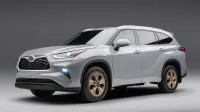2022 Toyota Highlander Hybrid Bronze Edition Road Test | Cold but competent

I drove the 2022 Toyota Highlander Hybrid Bronze Edition back in January, which was awkward timing, really. Bronze seems like an odd choice for an Olympic year. Sure, it’s thematically consistent, but it also seems a bit self-deprecating. While it wouldn’t make much sense to call something with bronze wheels a “Gold” or “Silver” edition, we’ve already seen the liberties Toyota is willing to take with its special edition model names. Surely something that didn’t suggest a third-place finish was available?
The Highlander was delivered in frigid conditions that persisted throughout the week. This immediately reminded me just how long it takes to heat the cabin of a three-row crossover in sub-freezing temperatures. The hybrid powertrain didn’t seem to make matters better. The Highlander frequently started up without the internal combustion engine, which seems problematic when you want to circulate coolant to run a heater, but I’m certain Toyota’s engineers thought of that. And the seat and steering wheel heaters — which couldn’t possibly rely on hot water from the engine — were just as sluggish.
But this warm-up time gave me the chance to familiarize myself with the Highlander’s cabin. The Bronze Edition is exclusive to the Hybrid. Based on the XLE, it’s available in one of three colors — Cement (which is exclusive to Bronze), Wind Chill Pearl (new for ’22) or Midnight Black Metallic (that’s black) — with a smattering of bronze accents outside and in.
In addition to the equipment that comes standard on the XLE, the Bronze Edition adds a hands-free power liftgate, rain-sensing wipers, a digital rearview mirror, upgraded power outlets, puddle lamps, in-dash ambient lighting and a 10-way power adjustable driver’s seat with memory. It’s a popular equipment package with bronze accents, in other words.
This was the first time I’ve actually driven the new Highlander Hybrid, and apart from the aforementioned gripes with the cabin temperature, which I chalk up to a simple reality of living with a large car in the Midwest, my biggest gripe is with the infotainment, which is based on the 8-inch system that is standard all the way down to the LE model (Limited and Platinum have access to a much better 12.3-inch unit).


That said, the 8.0-inch unit still boasts a reasonably impressive standard feature list, including Android Auto, Apple CarPlay and four USB charge ports. And since this tester came without the optional navigation upgrade, the small screen’s ho-hum display resolution isn’t much of an annoyance. Still, it would be nice to see the 12.3-inch unit available lower in the lineup as it’s a significant upgrade in usability (plus, the Kia Telluride’s own widescreen display is now standard throughout its line).
The Bronze Edition’s strength is that it’s based on the Hybrid, which is inherently advantageous in a segment where few exist. The Ford Explorer is the Highlander’s dynamic superior thanks to its RWD chassis and generally sportier tuning but you’ll pay thousands more up front and its combined 27 mpg figure pales in comparison to the Highlander’s 36. Even in the cold, the Highlander managed 31 mpg combined during my short time behind the wheel.
Most of that time was spent in snow, which allowed the Highlander’s all-wheel-drive system the opportunity to distinguish itself. While it had no trouble wrangling the Hybrid’s 243 horsepower on cold, dry pavement, the white stuff made things a bit trickier. Toyota says the Bronze Edition checks in at 4,515 pounds with AWD; that’s quite a bit of mass to rein in. A decent set of snow tires would go a long way to improving winter confidence.
While there’s nothing particularly exciting about it, the Highlander Hybrid is as efficient as three-row gasoline-powered SUVs get. Its lack of edge makes it comfortable but not sloppy, and it’s the kind of cruiser that can pack away hundreds of mindless freeway miles with little effort — and longer stretches between fuel stops.
Related Video
.embed-container { position: relative; padding-bottom: 56.25%; height: 0; overflow: hidden; max-width: 100%; } .embed-container iframe, .embed-container object, .embed-container embed { position: absolute; top: 0; left: 0; width: 100%; height: 100%; }




